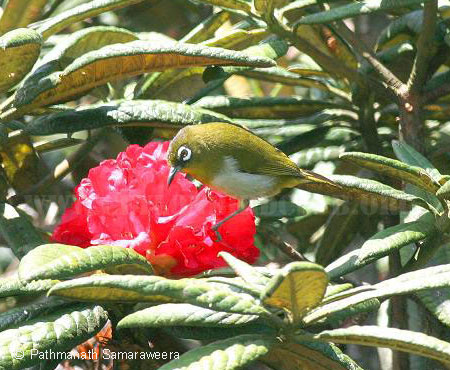


Ceylon Hill White-eye Zosterops ceylonensis
(Sri Lanka White-eye)
Sinhalese - Mal Kurulla
Tamil - Pu Kuruvi

The Hill White-eye is possibly the commonest bird of the higher hills. Troops of these little birds are seen moving about actively, uttering loud chirps, in well wooded gardens, orchards, woods and forests. The troop would assiduously search a tree or bush for the insects, berries and nectar on which they feed and then fly to the next and continue their feeding thereon. They are very beneficial birds as they consume large quantities of caterpillars in their daily quest for food. The Hill White-eye is a nucleus species in bird waves which traverse the hill forests. Compared to the Hill White-Eye, its smaller cousin the Small White-Eye definitely has more sedate habits and much softer calls. At times the Hill White-eye descends to almost 500 metres elevation so that the territories of both our White-eyes overlap. Though the present species occurs up to the highest hills, the Small White-eye is uncommon above 1700 metres elevation. Both species have conspicuous white rings around the eyes. The Hill White-eye is however larger, though still smaller than a House sparrow, and greener than the Small White-eye.
Senior Ceylon Bird Club member Dr T S U De Zylva in his book Birds of Sri Lanka (1984) writes “ Hill White-eyes often visit the blossoms of wild rhododendrons in search of nectar. The sight of a Hill White-eye sitting on a cluster of these crimson blossoms against the backdrop of a distant valley, makes one stop and take a deep breath…”
It is indeed a breathtaking sight to see a troop of Hill White-eyes flitting amongst the bright red blossoms and deep green leaves of a Rhododendron in the Horton Plains.
The breeding season is from March to about May with a secondary season from August to September. During this time the large or small troops these birds normally associate in, break up into pairs. The birds build a hammock like nest out of moss and fibre which is generally placed low in a well foliaged tree or bush. Two pale blue eggs are laid.